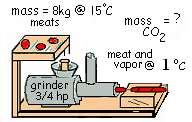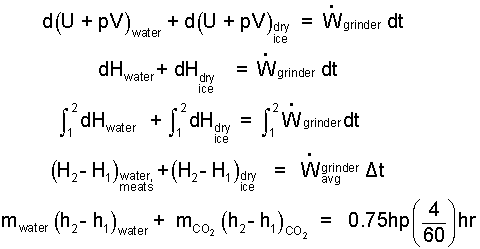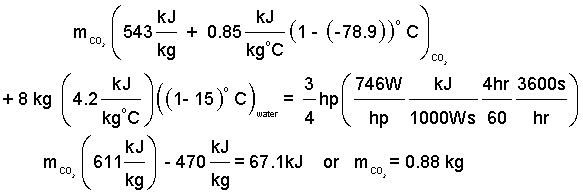| THERMO Spoken Here! ~ J. Pohl © ( D8600~2/15) | ( D8620 - Ice versus Dry Ice) |
Sausage Preparation

Once the ingredients of sausages are ground, they must be refrigerated promptly. To hasten chilling, pulverized dry ice (solid carbon dioxide) is fed directly into the grinder as the meats and spices are ground the last time.
The sketch shows ingredients for a "batch" of sausage (at 15oC) just prior their last pass through the grinder. Crushed dry ice (solid carbon dioxide) is added this time. Assume the grinder, which requires four minutes of its 3/4 HP motor for the final grind, is thoroughly insulated. The final condition required is that the meats and carbon dioxide exit the grinder at a temperature of 1°C.
Calculate the least amount of Dry Ice that must be added to the mix.
♦ Take the system to be the meats (with properties approximated as those of water) and the dry ice. This is an "increment" type event. However, we begin by writing the rate form of the energy equation. The rate form is always used since it reduces to the other forms as will be shown:

| (1) 1 |
We inspect the energy equation, term by term beginning with the Σ at the left. That summation applies because two substances pass through the grinder. The internal energies of the dry ice, Udry ice, and meats, Umeat, will change. However, we expect inconsequential (center of mass) changes of kinetic or potential energy for the dry ice and meats (water) (X). Zero extrinsic energy change also means zero extrinsic work (X). We write the rate of "compression work" as two pieces - one for dry ice, the other for the meats. There is a single shaft work, that of the grinder motor. This leaves frictional work and the sum of heats. Both frictional work and heat will increase the amount of dry ice needed - we assume frictional work and heats are negligibly small (/).
Finally, the heat term is always difficult to evaluate. Here we seek the least dry ice required which will correspond to the sum of heats ΣQ being zero. The next stage of our equation is:

| (2) 2 |
Processes of the water and the dry ice begin at a pressure of one atmosphere and terminates at one atmosphere. For that reason, pressure is assumed constant for the water and carbon dioxide. Recognizing this we change the integrals as follows:

| (3) 3 |
Multiply the equation by "dt." On the right side, multiplication by "dt" leaves the combination "d∫." Do you remember that from calculus? The result is:

| (4) 4 |
The very convenient grouping enthalpy (U + pV) occurs often in thermodynamnic analysis. We group the terms.

| (5) 5 |
We must now express the enthalpy differences quantitatively. Since we know more about water than carbon dioxide, we apply the solid principle "easier things first." The meat, approximated to be water, enters the grinder modeled as a liquid and leaves colder but still liquid at 1°C. The second, or exiting enthalpy is greater than the first.

| (6) 6 |
We know the specific heat of water and its entering and leaving temperatures. The difference we seek is:

| (7) 7 |
The CO2 is initially solid at one atmosphere and has a low energy. During grinding its energy increases with its phase change from solid to gas (heat of sublimation) and thereafter by its temperature increase to that of the meat, 1°C. The energy of each of these changes is positive. Thus we write the second enthalpy of the dry ice as:

| (8) 8 |
The difference we need is:

| (9) 9 |
The brief table provides properties of Carbon Dioxide.
| Carbon Dioxide at 101 kPa | |||||
| T (°C) | ρsol(kg/m3) | ρgas(kg/m3) | hsol(kJ/kg) | hgas(kJ/kg) | cp,vap(J/g°C) |
| -78.9 | 1565 | 2.51 | 70 | 643 | 0.85 |
| Carbon Dioxide, (CO2), sublimes at -78.9°C | |||||

| (10) 10 |
The property information for water and carbon dioxide are entered into our equation.

| (11) 11 |
There are two specific heats for gases:
| ΔU = cv,averageΔT and ΔH = cp,avgΔT. | (12) 12 |
Sausage Preparation

Once prepared, sausages must be refrigerated promptly. The sketch shows ingredients for a "batch" of sausage (at 15°C) just prior their last pass through the grinder. To hasten chilling, rushed dry ice (solid carbon dioxide) is added this time. Assume the grinder requires four minutes of its 3/4 horsepower (HP) motor for the final grind. The final condition required is that the meats and carbon dioxide exit the grinder at a temperature of 1°C. Calculate the least amount of Dry Ice that must be added to the mix.
Premise presently unwritted!